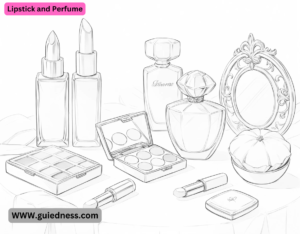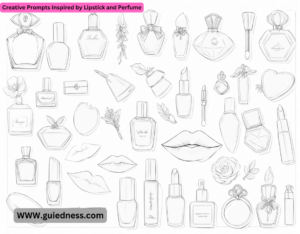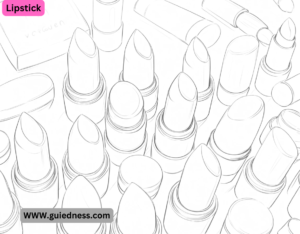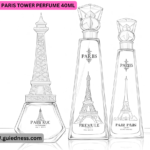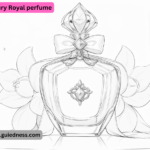Lipstick and Perfume Power and Confidence: Lipstick is often seen as a symbol of empowerment. A bold red lip, for example, can convey strength, sensuality, and independence.
- Transformation: Applying lipstick can be a ritual of transformation, marking the transition from one role or mood to another (e.g., from casual to formal, or from private to public).
- Femininity and Identity: Lipstick is deeply tied to gender expression and cultural norms around beauty.
Perfume:
- Memory and Emotion: Perfume is strongly linked to memory and emotion. A specific scent can evoke nostalgia, love, or even loss.
- Invisibility and Presence: Perfume is intangible yet leaves a lasting impression, much like a person’s aura or personality.
- Seduction and Mystery: Perfume has long been associated with allure and intrigue, often used to captivate or entice.
- Together, lipstick and perfume can symbolize the art of self-presentation—how we curate our external image to reflect our inner selves or desires.
2. Cultural and Historical Significance
- In ancient civilizations (like Egypt and Mesopotamia), lipstick was a status symbol, worn by both men and women.
- During World War II, lipstick became a symbol of resilience and morale-boosting for women.
- In modern times, it has been a tool for self-expression and rebellion, such as in the punk and goth subcultures.
Perfume:
- Perfume has ancient roots, used in religious rituals, as a status symbol, and for personal adornment.
- In the 20th century, iconic perfumes like Chanel No. 5 became symbols of luxury and sophistication.
- Today, niche and personalized fragrances reflect individuality and creativity.
3. In Literature and Art
- Often used as a metaphor for desire, transformation, or even danger (e.g., the “femme fatale” trope).
- In poetry, lipstick stains might symbolize a fleeting moment or a lingering memory.
Perfume:
- Patrick Süskind’s novel Perfume: The Story of a Murderer explores the power of scent to manipulate and captivate.
- In visual art, perfume bottles and lipstick tubes are often depicted as symbols of vanity or luxury.
- Together, they can represent the duality of appearance versus essence—what we show to the world versus who we truly are.
4. In Music
- Songs like Lipstick and Perfume by John Anderson tell stories of love, loss, and longing. The lyrics often use these items as metaphors for what remains after a relationship ends.
- Other songs might use lipstick and perfume to evoke themes of seduction, nightlife, or personal identity.
5. Personal and Emotional Connections
Lipstick:
- For many, lipstick is a daily ritual, a small act of self-care that boosts confidence.
- It can also be a way to reclaim identity, especially for those going through transitions (e.g., cancer survivors wearing lipstick after treatment).
- People often associate specific scents with loved ones or significant moments in their lives.
- Choosing a signature scent can be a deeply personal and emotional process.
6. Creative Prompts Inspired by Lipstick and Perfume
- If you’re looking to create something inspired by these themes, here are a few ideas:
- Writing: Write a poem or short story about a character who leaves behind only their lipstick and perfume after a breakup.
- Art: Create a visual piece that contrasts the boldness of lipstick with the subtlety of perfume.
- Photography: Capture the essence of these items in a still-life composition, focusing on texture, color, and light.
- Fashion: Design a collection inspired by the duality of lipstick (bold, visible) and perfume (subtle, lingering).
The Chemistry of Lipstick and Perfume
- Ingredients: Modern lipsticks are made from a blend of waxes (like beeswax or carnauba wax), oils (like castor oil or lanolin), pigments, and emollients. Some also include moisturizers, SPF, or plumping agents.
- Formulation: The balance of wax and oil determines the texture—matte, satin, or glossy.
- Longevity: Advances in chemistry have led to long-wear and transfer-proof formulas that stay put for hours.
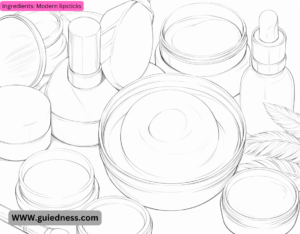
Perfume:
- Composition: Perfumes are made up of top notes (the initial scent), middle notes (the heart of the fragrance), and base notes (the lingering scent). These are derived from essential oils, synthetic compounds, and fixatives.
- Concentration: Perfume strength varies from eau de cologne (lightest) to parfume (most concentrated).
- Chemistry of Scent: Molecules in perfume interact with your skin’s pH and natural oils, creating a unique scent for each individual.
2. Cultural Evolution
- Ancient Times: Lip color dates back to ancient Mesopotamia and Egypt, where crushed gemstones and natural dyes were used. Cleopatra famously wore red lipstick made from crushed carmine beetles.
- 20th Century: Lipstick became a symbol of women’s liberation in the 1920s, with the rise of flapper culture. During WWII, it was seen as a morale booster for women in the workforce.
- Modern Day: Lipstick is now a global industry, with trends like liquid lipsticks, lip stains, and eco-friendly packaging.
- The Romans and Arabs later refined distillation techniques.
- Renaissance to Modern Era: Perfume became a luxury item in Europe, with France emerging as the epicenter of fragrance innovation.
- Today: Niche and artisanal perfumes are gaining popularity, with a focus on unique, personalized scents.
3. Psychological Impact
- Studies have shown that wearing lipstick can boost confidence and self-esteem.
Color psychology plays a role too: red lipstick can convey power and passion, while nude shades suggest simplicity and elegance.
Perfume:
- Scents have a direct link to the limbic system, the part of the brain that controls emotions and memories. This is why a particular fragrance can instantly evoke a mood or memory.
- Wearing perfume can enhance self-perception and influence how others perceive you, often on a subconscious level.
4. Lipstick and Perfume in Storytelling
Film and TV:
- For example, in Breakfast at Tiffany’s, Audrey Hepburn’s red lipstick and pearls became iconic.
- In American Horror Story: Coven, the character Fiona Goode uses her signature perfume as a metaphor for her power and allure.
Literature:
- In The Great Gatsby, Daisy Buchanan’s perfume and lipstick symbolize her glamour and the illusion of perfection.
- In Perfume: The Story of a Murderer, scent is the central theme, exploring obsession and the darker side of human nature.
Advertising:
- Brands like Chanel, Dior, and MAC have built entire campaigns around the allure of lipstick and perfume, often tying them to themes of empowerment, romance, or mystery.
5. The Business of Beauty
Lipstick:
- The global lipstick market is worth billions, with trends like vegan, cruelty-free, and sustainable products driving innovation.
- Celebrity collaborations (e.g., Rihanna’s Fenty Beauty, Kylie Jenner’s Kylie Cosmetics) have revolutionized the industry.
Perfume:
- The fragrance industry is equally lucrative, with luxury brands like Chanel, Tom Ford, and Jo Malone dominating the market.
- Niche perfumers like Byre do and Le Labo cater to consumers seeking unique, non-mainstream scents.
6. Lipstick and Perfume as Symbols of Rebellion
- In the 1970s, punk culture used bold, unconventional lipstick colors (like black or blue) to challenge societal norms.
- Today, lipstick is a tool for activism, with campaigns like “Lipstick Lobby” advocating for political change.
Perfume:
- Historically, wearing perfume was a way to assert individuality and status. In modern times, unisex and gender-neutral fragrances challenge traditional gender norms.
………….Lipstick and Perfume…………

